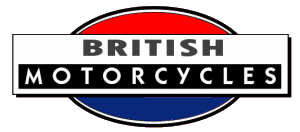


William Hillman partnered with James Starley in the 1870s. Their works led to the invention of both the safety bicycle and the rubber tyre, and to the establishment of such bastions of the British Motorcycle Industry as Ariel, Rover and Rudge-Whitworth.
Hillman produced his first motorcycle in 1902 under the his own name. Aspects of the machine are described as "very modern", in the page linked above. In 1908 he began building motorcycles under the Premier marque, and continued until 1916. After the war the firm built three-wheelers, and ceased production around 1920. The motorcycles were built under licence in Czechoslovakia in the 1920s and throughout the 1930s.
1908 A model was produced that had a 3½ hp White and Poppe engine, Brown and Barlow carburettor, Bosch magneto and belt drive. It had Chater-Lea front forks.
1909 By now they were building their own version of the engine and their own design of forks replaced the original Chater-Lea. They took an injunction against Premier Motor Co over the use of the name Premo.
1910 The single was joined by a 3¾ hp V-twin that had horizontal cooling fins and a crankshaft that allowed both pistons to move together despite its angle. Late in the year, a completely new 3¾ hp V-twin engine was announced, and this had cylinders set at 45 degrees and kept the horizontal cooling fins. A two-speed gear was available.
1910 Stanley Show Report
Premier Cycle Co., Ltd.
Coventry.
The 1911 Premier motor-cycles will contain many new features, amongst which may be mentioned the 3 1/2 H.P. single cylinder engine with an auxiliary exhaust release at the bottom of the stroke. This feature was introduced by the Premier Co. during the past season, and it is probably the first time an engine embodying the innovation has ever been shown at a cycle exhibition.
Another model will be fitted with the new Premier twin engine with cylinders firing at even intervals without the adoption of two throw crank and staggered cylinders. This engine resembles many other twin motors at first glance, but in principle it is entirely different.
A third model will be exhibited fitted with the new Premier free engine clutch, which possesses many interesting features, whilst all models are equipped with an adjustable pulley of entirely new design. A fourth model is the Premier T.T. Racer, which will prove of great interest to speed lovers. Altogether, the Premier motor-cycle exhibit will be found to be most interesting to those who closely follow the advancement of motor-cycle engineering.
Cycle and Motor Trades Review
1911 A 2hp lightweight model joined the range. It had its engine mounted inclined in a loop frame above the pedals. It had a rear-mounted Bosch magneto, belt drive and Druid forks. Later, a 2½ hp single was added.
1912 Premier Cycle Co listed at Hertford St. and Lincoln St (Tel. 796), Read St (Tel. 514), Coventry and as manufacturers of motorcycles.
1912 The range now included a 3½ hp ladies' model with open frame.
1912 Models.
3½ h.p. Type.
Standard Tourist, £47 10s.
Extras: £7 7s. for Premier Free Engine Clutch. £10 10s. for Armstrong 3-speed or Millennium 2-speed gears.
Competition Models. No. 5. with dropped bars. No. 6, with flat bars and Carrier. £47 10S.
Lady's Model.
With Premier Free Engine Clutch, £60, and £63 with Armstrong 3-speed gear.
2½ h.p. Type.
Standard Model.
£36.
Extras: Premier Free Engine Clutch, £7 7S., Armstrong 3-speed, £10 10s.
3¾ h.p. Type.
Standard Model, £52 10s. Extras as 3½ h.p. Type.
Advertisement in The Motor Cycle March 21st 1912
1913 They produced a 499cc side-valve 3-speed machine, and brought in a two-speed gearbox and Druid forks for the 3½ hp single. In came a new V-twin with increased power and out went the 2hp model.
1914 A new model was announced, but few were built. It had a 2¾ hp in-line, twin-cylinder, two-stroke, over-square engine of 322cc, mounted in a duplex frame.
Premiers in the Army.
A number of 3½ h.p. Premier countershaft three-speed machines has been supplied to the War Office for use with the Expeditionary Force, and two machines for Lord Lonsdale's Colonial Corps.
The Motor Cycle, August 27th 1914.
1914 The company produced a range of motorcycles including a four-stroke 250 (below) and a 296cc two-stroke. That year the company name was changed to Coventry Premier. After the First World War the company did not resume motorcycle production.
PREMIER.
Engine - 2½ h.p. four-stroke Premier, 66x72 mm., 246 c.c.
Iqnition - Bosch magneto, gear driven.
Carburetter - B. and B.
Change Speed - Three models, single-gear, single-gear clutch, three-speed Armstrong hub.
Transmission - Belt.
Dimensions - Height of saddle from ground, 30in. Ground clearance, 6in. Wheelbase, 50in.
Lubrication - Splash.
Other Features - Druid forks. Clincher tyres.
Price - £36. Clutch, £42. Three speed, £44 15s.
Premier Cycle Co., Ltd., Coventry.
1915-1916 The range was still listed.
Post-WWI. The company concentrated on a three-wheel Runabout.
1921 Company was acquired by Singer. Premier motorcycles were produced under licence in Czechoslovakia throughout the 1930s.
1896 The New Premier Cycle Co was registered on 29 June to acquire the business of the Premier Cycle Co. Directors are: Warington Baden-Powell, Colonel C. E. MacDonald, Alexander Rotherham, George Francis Twist and William Henry herbert.
1896/7 Directory: Listed under cycles as New Premier Cycle Co. Limited, of Premier Works.
1902 The original title of Premier Cycle Co was reverted to.
1912 Listed in Spennell's directory of Coventry as Cycle Manufacturers.
1913 The German operation goes in to receivership and the Japanese operation is in trouble.
1915 Further losses mainly due to operation in Japan.
1914 Changed the name to Coventry Premier Ltd
Notes: 1. The 1902 Hillman reference also appears in a piece by the Coventry Transport Museum, which says, "Hillman himself waited until 1902 to develop an experimental motor-bicycle."
Sources: Graces Guide, The Motor Cycle, et al
If you have further information or a query related to this page, please contact us